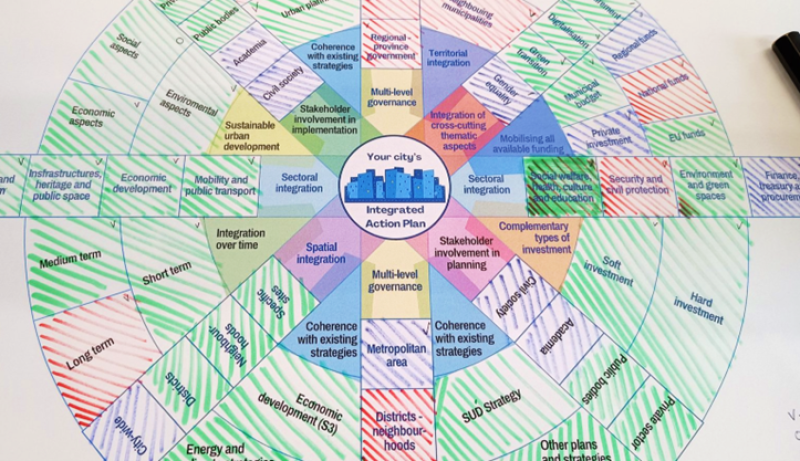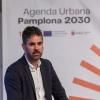Joist Innovation Park: A Hub of Green Entrepreneurship
If Joist’s exterior is eye-catching, the interior is even more impressive. The entrance hall, towering nearly eight meters high, is dominated by an enormous steel beam—perhaps the inspiration behind the name ‘Joist’. The space is a fusion of an industrial warehouse and a Silicon Valley co-working hub. The original steel columns, beams, and riveted metal panels remain visible, yet instead of rust, they are painted in vivid shades of purple, yellow, and deep blue. The large, tiered seating area doubles as a conference hall and theatre, while glass partitions reveal offices, workshops, and meeting rooms designed to foster collaboration and innovation.
Joist is one of 57 good practices identified among In4Green network partners. This privately funded initiative transformed an old industrial site into a thriving ecosystem for innovation and entrepreneurship—rooted in sustainability and circular economy principles. Every element of the space is designed to inspire, encourage, and make collaboration enjoyable.

The model has been so successful that Joist is now expanding beyond Greece. “There is strong interest from India, and we are in discussions to replicate the model in several cities with a local partner,” says Katerina Diminikou, Joist’s Event and Communication Manager, as she guides visitors through the space. A prime example of how a city in the In4Green network is not only contributing to Europe’s green transition but also exporting its expertise worldwide.
A Mandala Approach to Integrated Planning
Joist Innovation Park provided the ideal setting for the first day of the Fourth Transnational Meeting of the URBACT In4Green network. The morning began with parallel workshops: Lead Expert Jose Costero guided participants through the challenges of developing green and smart industrial zones, green technologies, and investment attraction, while URBACT expert Eileen Crowley led discussions on circular economy strategies. These sessions provided tools, methodologies, and insights on monitoring, evaluation, funding schemes, and integrated action plan design.
After a series of best practice exchanges—where cities like Sabadell and Famalicão showcased their support programs for entrepreneurship and SMEs—the meeting shifted focus to the core of In4Green’s mission: developing Integrated Action Plans (IAPs). But how do you effectively teach the concept of integrated planning?
Jose Costero found inspiration in an unexpected source: Indian culture. “One of the hardest aspects of the URBACT methodology to explain is the integrated approach—bringing together different administrative levels, territorial considerations, policy themes, and stakeholder categories. It’s like a 360-degree vision of local policy,” he explains. And how do you illustrate such a complex concept? With a mandala.

Derived from Sanskrit, the word ‘mandala’ means ‘circle’—a symbol of wholeness, balance, and interconnectedness. “A circle that also represents how everything is linked, just like local policies,” Jose adds. He introduced the ‘Mandala of Integrated Planning’, a visualization exercise where participants coloured sections of a diagram representing various dimensions of the URBACT integrated approach. Each colour indicated whether a particular factor was fully considered, partially addressed, or overlooked in their local action plans. By the end of the exercise, each city had a clear visual representation of where they stood and what gaps needed to be addressed.
“It really helped us understand how everything connects in our action plan,” remarked Anna Puiggros from Sabadell.

From Industrial Past to a Sustainable Future
The second day of the meeting took place at the Mill of Pappas, a historic flour mill transformed into a cultural hub. Here, participants explored how Larissa, historically known as Greece’s breadbasket, is leveraging its fertile lands and heritage to shape a sustainable future.
One of the key moments of the gathering was the peer review of the Integrated Action Plans. Over two hours, In4Green partners engaged in deep discussions, exchanging ideas and feedback on their action plan drafts in small working groups. The hands-on, interactive format ensured that cities could refine their approaches, learning from each other’s successes and challenges.
By the end of the second day, exhausted but inspired, the In4Green teams and stakeholders returned home, carrying new insights, strategies, and connections. The meeting in Larissa proved that green transition is not just about policies and infrastructure—it’s about people, creativity, and collaboration. And sometimes, it’s about mandalas too.
About the Fourth Transnational Meeting of the URBACT In4Green Network
On March 11-12, 2025, Larissa hosted the Fourth Transnational Meeting of the URBACT In4Green network, where partners continued their collaborative learning and peer exchange to co-produce their local green transition strategies. The event brought together around 40 participants from 10 European cities, including Lead Expert Jose Costero and URBACT Ad Hoc Expert Eileen Crowley.
The URBACT In4Green network is co-financed by the European Commission through the European Regional Development Fund (ERDF).


